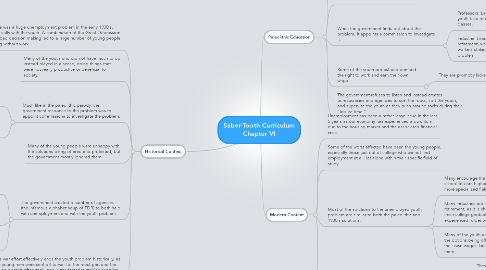
1. Historical Context
1.1. There was a huge unemployment problem in the early 1930's, especially with the youth. A combination of the Great Depression and bad decision making led to a large number of young people being without work.
1.2. Many of the youth who did not have much to do instead played in a sense, doing things that were not really productive or beneficial to society.
1.3. Much like in the paleolithic parody, the government response to the problem was to appoint commissions to investigate the problem.
1.3.1. Also like the paleolithic parody, the educators recommended students return to school for more specialization.
1.3.2. Similarly, the industrialists were trying to enforce earlier retirements during this time, as young people were a cheaper source of labor and were less likely to be involved in unions that were striking and costing the industrialists a lot of money.
1.4. Many of the young people were unhappy with the solutions being offered and protested, but the government mostly ignored them.
1.5. The government created a number of agencies (the infamous alphabet soup of FDR) to both help with unemployment and with the youth problem.
1.5.1. Many public works projects were developed to provide jobs for people. Most of these required no effort (they are known as shovel leaning jobs), and so the youth were still not effectively employed.
1.5.2. Civilian Conservation Corps: Young, unemployed men given on-the-job training in various occupations. Gradually transitioned to a more school-like atmosphere which the youth here and the CCC weren't prepared for.
1.5.3. National Youth Administration: Provides government assistance for those who work while also going to school.
1.6. The war effort effectively ends the youth problem historically, as the young men were sent off to war for the most part and the young women often took jobs in the factories making supplies and munitions.
2. Paleolithic Education
2.1. Huge unemployment of the youth due to the depression caused by the consolidation of fishers, snarers, and trappers.
2.2. Young people push around rocks and play with them as they have no work to do.
2.3. When the government finds out about the problem, it appoints a commission to investigate it.
2.3.1. Professors: Let's make the youth take more specialized classes.
2.3.2. Industrial Leaders: force all older workers into early retirement, which fixes both the problem of the older workers striking and the unemployment of the youth problem
2.4. Some of the youth protest and demand the right to work and earn their own wage.
2.4.1. They are promptly kicked out of the meeting.
2.5. The government refuses to listen and instead creates bureaucracies and agencies to sort the rocks, sort the youth, and supervise the youth as they push around rocks during their "leisure time."
3. Modern Context
3.1. Unemployment has been a rather large issue in the last 5 years as our economy has experienced a downturn due to the housing market and the associated financial crisis.
3.2. Some of the worst affected have been the young people, especially those just out of college who cannot find employment at all, let alone within their specific field of study.
3.3. Most of the solutions to the unemployed youth problem are similar to both the paleolithic and 1930's solutions.
3.3.1. Many encourage the unemployed to go back to school to earn higher degrees (MA, PhD) in more specialized fields.
3.3.2. Many industries are trying to force older employees into early retirement, as it is cheaper for them to pay a lower wage to a fresh college graduate than to pay a higher wage for an experienced, older worker.
3.3.3. Many of the youth are discouraged and unhappy with the options being offered. They want to work and earn their own wages, but the opportunities are not there for them.
3.4. While not as specifically focused as in the past, the government has set up panels to study both the unemployment issue and issues related to the youth problem (in particular the increasing trend of unemployed college graduates).
3.4.1. These studies have focused mostly on the causes of the economic depression and how to alleviate it. They are less focused on how to best employ the youth of America.
3.4.2. There have been some discussions, however minor, about the possibility of the creation of more public works to help alleviate the unemployment problem. It is unknown if these will be "shovel leaning" jobs or not.
